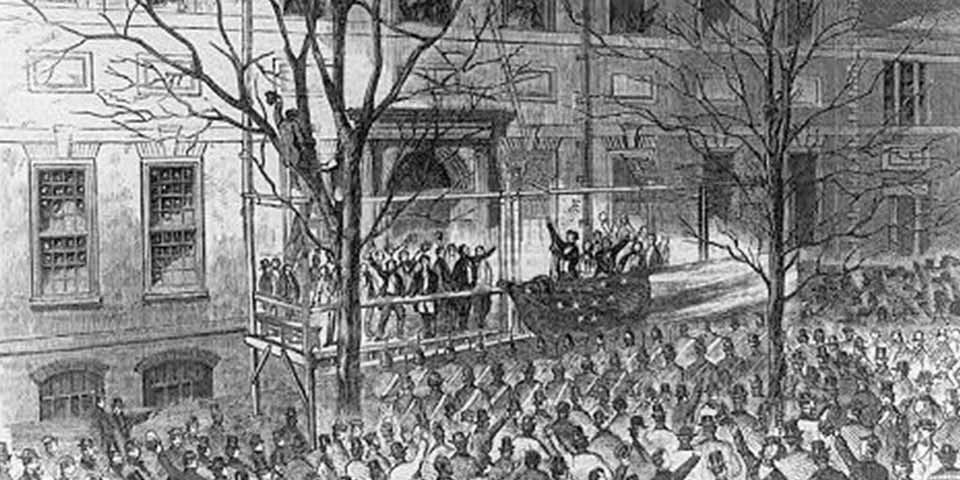Last updated: January 3, 2023
Article
Independence Hall and the American Civil War

Library of Congress, Harper's Weekly, March 9, 1861
Independence Hall, and the square on which it sits, played a part in the American Civil War – hosting Abraham Lincoln and serving as a vital recruitment center for Union Army enlistees.
Abraham Lincoln at Independence Hall
February 1861
Early on the morning of February 22 – George Washington’s birthday – President-elect Abraham Lincoln arrived at Independence Hall. For ten days, he had traveled across the country on his inaugural journey to Washington, DC. Now, standing at the birthplace of the nation, Lincoln sought to reassure the nation that bloodshed could be avoided. In an emotional speech inside the Assembly Room, the place where the Declaration of Independence and U.S. Constitution had been signed, Lincoln pondered the meaning behind those words “all men are created equal.” He stated: “It was not the mere matter of the separation of the Colonies from the motherland; but something in that Declaration giving liberty, not alone to the people of this country, but hope to the world for all future time. It was that which gave promise that in due time the weights should be lifted from the shoulders of all men, and that all should have an equal chance...But if this country cannot be saved without giving up that principle, I was about to say I would rather be assassinated on this spot than surrender it."
Following the speech, Lincoln emerged from Independence Hall to raise a new 34-star flag honoring the admission of Kansas to the union. Despite the early hour, enormous crowds had already gathered for the ceremony. Lincoln quickly left Philadelphia after the flag raising, continuing his journey to Washington, DC. Within two weeks, he became the 16th President of the United States. Civil war broke out on April 12, 1861.
Camp Independence – a Recruitment Camp on Independence Square
Fall 1862
Military officials opened a Union recruitment camp on Independence Square, directly in the shadow of Independence Hall in September 1862. By then, hopes for a short-lived conflict had been dashed. Fewer men enlisted, and in Pennsylvania, the situation was critical. The first tents appeared on September 8, 1862. The next day, the Philadelphia Inquirer reported: “INDEPENDENCE SQUARE A VAST RECRUITING STATION.” Officially named Camp Independence, the grounds hosted a total of 25 tents. The location of the camp attracted a great deal of attention, both from potential military recruits as well as curious spectators.
Often times, the atmosphere seemed almost festive. The Philadelphia Inquirer described the scene: “The Square was brilliantly illuminated with lanterns of various colors and devices, stretched from tent to tent and tree to tree. Drums were beating up recruits in various parts of the ground, and the whole formed an ensemble the very opposite of the scenes usually produced by ‘grim-visaged war.”
The soldiers recruited at Camp Independence traded the comforts of Philadelphia for the harsh realities of the battlefield. More than two years of bloody conflict remained.
Mourning President Lincoln at Independence Hall
April 1865
Eight days after President Lincoln was shot in Washington, DC, the funeral train bearing his body arrived in Philadelphia, heading for Independence Hall.As the horse-drawn hearse moved slowly through the city streets, about 500,000 onlookers watched solemnly. After sunset, with bells pealing and bands playing a mournful dirge, the procession reached Independence Hall. Lincoln lay in repose inside the Assembly Room, the place where he had spoken of his reverence for the founding fathers in 1861. Mourning black adorned the room from floor to ceiling. Special stairs were built to allow the mourners to pass in and out of the building through the windows.
Several hundred invited guests viewed the president’s body that first evening. The casket lay in the shadow of the Liberty Bell while a statue of George Washington seemingly stood guard nearby. All around the room, portraits of the founding fathers silently gazed upon the scene.
Outside Independence Hall, long lines of mourners stretched for miles. For 20 hours on April 23-24, close to 100,000 people passed by the president’s remains, paying their final respects.
Lincoln’s body left Philadelphia early on the morning of April 24 and continued on to final burial in Springfield, Illinois.
Connect with the American Civil War at Independence National Historical Park…
- Find the plaque marking the spot of Lincoln’s flag-raising
- Listen for the Centennial Bell - it contains melted down cannons from the American Revolution and the Civil War. Hear it ring from Independence Hall every hour on the hour.
- Tour Independence Hall to see the room where Lincoln’s body and those of over a dozen Union officers once lay in state.
- View the Liberty Bell - this bell became a symbol of reconciliation between North and South when it traveled to New Orleans in 1885.
Print and Web Resources
Abraham Lincoln online. Abraham Lincoln's Address in Independence Hall, February 22, 1861.
Mires, Charlene. Independence Hall in American Memory. Philadelphia: University of Pennsylvania Press, 2002.
The Philadelphia Inquirer, February 23, 1861.
The Philadelphia Inquirer, September 9, 1862.
Abraham Lincoln online. Abraham Lincoln's Address in Independence Hall, February 22, 1861.
Mires, Charlene. Independence Hall in American Memory. Philadelphia: University of Pennsylvania Press, 2002.
The Philadelphia Inquirer, February 23, 1861.
The Philadelphia Inquirer, September 9, 1862.
